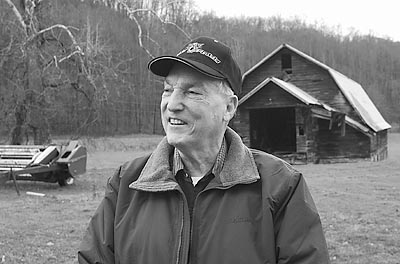“Fleetie Belle”
Adventures of a Tucker County Milk Truck
By Tom Felton

Morris White of Tucker County drove “Fleetie Belle” for a
couple of years before graduating from college. He later taught school
for 30 years. He is shown here at the former site of the Felton dairy
farm, with the old milking barn visible in the background. Photograph
by Michael Keller.
A college degree has always been a valuable commodity. However, in the 1940's and ‘50's, it was rare for a young man or woman in rural West Virginia to have the resources to pursue this dream. In Tucker County, several ambitious youths were able to complete their education thanks to a daily ride to the nearest college in the back of a milk truck provided by John Harold “Johnnie” Felton, the owner of a local dairy farm and my grandfather. The truck was affectionately known as “Fleetie Belle,” and this is the story of how these young scholars rode her to success.
The Holly Meadows Dairy was established in the early 1920's in the community of Holly Meadows, approximately two miles north of Parsons in Tucker County. The dairy originally milked 12 cows. This number eventually increased to 20 or more when a new barn was built in 1946. The milking was done by hand until a milking machine was purchased around 1949. The dairy was a family business owned by my grandfather and operated by him and his sons Robert (my father), Kenneth, and Fred. My grandmother Atha, my youngest uncle Jack, and my aunt Joanna washed bottles. Jack recalls a time when he was 10 years old and milked nine cows by hand because an impending storm had the older brothers putting up hay until dark.
For years, the dairy produced raw milk and delivered it by automobile to households in Tucker County. Eventually, the cars were replaced with Fleetie Belle — a 1936 Plymouth panel truck my granddad purchased from a local grocer. About 1946, the sale of raw milk ceased. Now the milk had to be transported daily to Elkins, more than 20 miles away in neighboring Randolph County, for processing. There the raw milk was pasteurized and bottled by the Elkins Dairy Plant, then returned to Parsons.
One of the drivers of Fleetie Belle was Glenn Shoemaker, today a resident of Alexandria, Virginia. Glenn would keep the milk truck overnight at his home in Parsons and pick the raw milk up at the farm at approximately 7 a.m. Several 10-gallon milk cans were loaded onto the truck for the trip to the bottling plant. As the truck drove through town on the way south to Elkins, Glenn would stop to pick up the “riders,” as they were known. The riders were all students at Davis & Elkins College, located in Elkins and commonly known as D&E. Most were regulars who had no other means of transportation. Occasionally, there would be a student who had regular transportation, but for whatever reason, did not have access to it on that particular day. The cans of milk would be delivered to the plant around 8 a.m., and then the driver and his passengers would go on to the college where they all took classes.
Around noon, when their classes were over for the day, the bunch would return to the dairy plant to pick up the finished product. They would make the return trip to Parsons, and the riders would disembark. The driver would then deliver the freshly bottled milk to various restaurants and grocery stores, which were in abundance in those days.
Eventually, the Plymouth became in poor repair and was replaced with a 1949 Chevrolet panel truck, which was bigger. The newer truck, also called Fleetie Belle, had bench seats, so the students no longer had to sit on milk crates for the journey to Elkins.
Through the years, the milk trucks were involved in several minor accidents. Many involved sliding into a ditch on snow- or rain-slickened roads. When that occurred, the passengers would have to get out of the vehicle and shove it back onto the highway.
You can read the rest of this article in this issue of Goldenseal, available in bookstores, libraries or direct from Goldenseal.